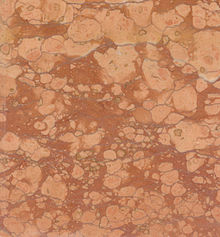Tuber lime

Knot limestone or knot limestone are limestones that are mostly eye- catching as colored rocks. Their formation through diagenesis (compression and cementation) of lime sludge, which is deposited in the seas and deformed into knot-like concretions , is a common explanation. The clay in the lime sludge was partially deposited in layers on the edge of the tuber and pressed. These processes lead to rock formation at depths of around 300 meters. In some nodular limestone, the clay mineral layers completely enclose the carbonate accumulations in the rock and thereby reinforce the visual impression that gives these rocks their name. In the case of red tuberous limestones, the color results from hematite . Numerous tuber limestone originated in the Devonian .
However, the formation of some tuber limestone is also explained by metamorphic processes. By tectonic stress formed on foliation processes and printing solution phenomena corresponding planar textures of the lime from lime Tonhäutchen to the remaining collections. The formation of the tuber limestone is a research area in which numerous geologists have been active since Hanns Bruno Geinitz and Carl Wilhelm von Gümbel and have come to different interpretations.
Use and occurrence
Because of their structurally changeable and colorful appearance, they have been used for decorative purposes. Depending on the weather resistance, they can be used outside or only inside.
In Europe, tuber limestone has been extracted in Bavaria, Thuringia, Saxony, Bohemia, Moravia, Hungary, northern Italy and southern France for architectural, sculptural purposes and for ebony . The varieties from Italy were mainly used as pillars and balustrades in the Bavaria area. In Italy, especially on Lake Garda, it is also used to make curbs and floor coverings on pedestrian walkways.
The Bavarian State Office for the Environment has declared the quarry on Hasslberg near Ruhpolding , in which nodular limestone is exposed as Ruhpolding marble , as a geotope.
Commercial grades
- Rosso Verona (Italy, Sant 'Ambrogio near Verona , ( Valpolicella ))
- Rosso Asiago (Italy, Asiago )
- Bianco Asiago (Italy, Asiago)
- Ruhpolding marble (Bavaria, Ruhpolding )
- Adneter Marmor , (Austria, Alps, Adnet )
literature
- Albrecht Germann, Ralf Kownatzki, Günter Mehling: Natural stone dictionary. 5. completely redesigned. and act. Ed., Callwey, Kempten 2003.
- Dorrik AV Stow: Sedimentary rocks in the area. An illustrated guide. Spectrum Academic Publishing House, Heidelberg 2008. ISBN 978-3-8274-2015-2
- Roland Vinx: Rock determination in the field. Elsevier, Munich 2005. ISBN 3-8274-1513-6
Individual evidence
- ↑ D. Richter: Shortening of fossils and formation of flaser and tuber limestone through dissolution processes in shale calcareous rocks . In: Geol. Mitt. (4) 1965, Aachen, pp. 235–248
- ↑ E. Hildebrand: About the chemical-physical conditions of the tuber limestone formation . In: Journal of the German Geological Society (80) 1928, pp. 308–342
- ^ Bavarian State Office for the Environment Quarry at Hasslberg near Ruhpolding . Geotope number: 198A21. Retrieved October 20, 2014

